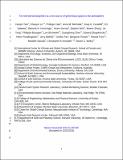The terrestrial biosphere as a net source of greenhouse gases to the atmosphere
Author(s)
Tian, Hanqin; Lu, Chaoqun; Ciais, Philippe; Michalak, Anna M.; Canadell, Josep G.; Saikawa, Eri; Huntzinger, Deborah N.; Gurney, Kevin R.; Sitch, Stephen; Zhang, Bowen; Yang, Jia; Bousquet, Philippe; Bruhwiler, Lori; Chen, Guangsheng; Dlugokencky, Edward; Friedlingstein, Pierre; Melillo, Jerry; Pan, Shufen; Poulter, Benjamin; Saunois, Marielle; Schwalm, Christopher R.; Wofsy, Steven C.; Prinn, Ronald G; ... Show more Show less
DownloadTian et al Nature Manuscript ACCEPTED.pdf (1.243Mb)
OPEN_ACCESS_POLICY
Open Access Policy
Creative Commons Attribution-Noncommercial-Share Alike
Terms of use
Metadata
Show full item recordAbstract
The terrestrial biosphere can release or absorb the greenhouse gases, carbon dioxide (CO[subscript 2]), methane (CH[subscript 4]) and nitrous oxide (N[subscript 2]O), and therefore has an important role in regulating atmospheric composition and climate. Anthropogenic activities such as land-use change, agriculture and waste management have altered terrestrial biogenic greenhouse gas fluxes, and the resulting increases in methane and nitrous oxide emissions in particular can contribute to climate change. The terrestrial biogenic fluxes of individual greenhouse gases have been studied extensively,but the net biogenic greenhouse gas balance resulting from anthropogenic activities and its effect on the climate system remains uncertain. Here we use bottom-up (inventory, statistical extrapolation of local flux measurements, and process-based modelling) and top-down (atmospheric inversions) approaches to quantify the global net biogenic greenhouse gas balance between 1981 and 2010 resulting from anthropogenic activities and its effect on the climate system. We find that the cumulative warming capacity of concurrent biogenic methane and nitrous oxide emissions is a factor of about two larger than the cooling effect resulting from the global land carbon dioxide uptake from 2001 to 2010. This results in a net positive cumulative impact of the three greenhouse gases on the planetary energy budget, with a best estimate (in petagrams of CO[subscript 2] equivalent per year) of 3.9 ± 3.8 (top down) and 5.4 ± 4.8 (bottom up) based on the GWP100 metric (global warming potential on a 100-year time horizon). Our findings suggest that a reduction in agricultural methane and nitrous oxide emissions, particularly in Southern Asia, may help mitigate climate change.
Date issued
2016-03Department
Massachusetts Institute of Technology. Center for Global Change Science; Massachusetts Institute of Technology. Department of Earth, Atmospheric, and Planetary SciencesJournal
Nature
Publisher
Springer Nature
Citation
Tian, Hanqin, Chaoqun Lu, Philippe Ciais, Anna M. Michalak, Josep G. Canadell, Eri Saikawa, Deborah N. Huntzinger, et al. “The Terrestrial Biosphere as a Net Source of Greenhouse Gases to the Atmosphere.” Nature 531, no. 7593 (March 9, 2016): 225–228.
Version: Author's final manuscript
ISSN
0028-0836
1476-4687